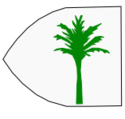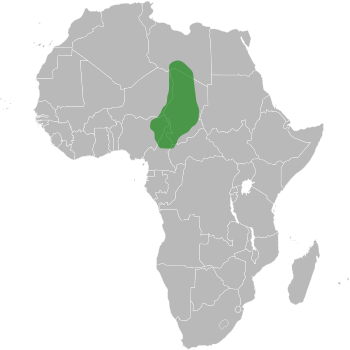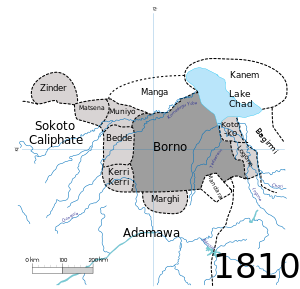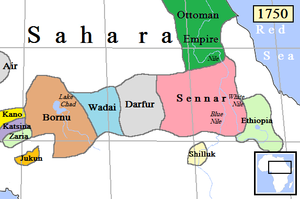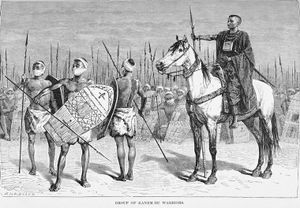سلطنة كانم-برنو
| ||||||||||||||||||||||||||||||||||||||||||||
| ||||||||||||||||||||||||||||||||||||||||||||
سلطنة الكانم ـ برنو دولة إسلامية قديمة نمت في شرقي بحيرة تشاد، وهي الدولة التي عرفت فيما بعد بدولة البرنو، عندما انتقلت إلى غربي بحيرة تشاد. وهي أكبر دولة نشأت في منطقة المراعي بين نهري النيجر والنيل. ولقد ضمن لها موقعها الجغرافي الممتاز مصدرًا مهمًا من مصادر الثراء.
يرجع أصل شعب هذه الدولة إلى الهجرات المختلفة لغربي إفريقيا، من البربر والزغاوة، في الفترة بين سنتي 184-648هـ، 800-1250م. وتعرض الزغاوة لهجرة جديدة من الطوارق الملثمين ومثلها من التبو والتيدا. ولم تكن هجرة شاملة، بل كانت على شكل أرستقراطية حاكمة استطاعت أن تخضع شعب الزغاوة لسلطانها، ثم أنجبت هذه الأرستقراطية أول أسرة مالكة سيطرت على المنطقة شرقي بحيرة تشاد، وأسست سلطنة كانم، ويرجع ملوك هذه الأسرة نسبهم إلى سيف بن ذي يزن الحميري، ولذا عرفت بالأسرة السيفية.
تعرضت كانم إلى ألوان متعددة من الصراع الداخلي في القرن الرابع عشر الميلادي بسبب ثورات بعض القبائل، وخلافات بين أفراد الأسرة الحاكمة، مما أضعف دولة كانم، ثم قامت قبائل البولالا باحتلال نجيمي عاصمة الدولة، ففرت الأسرة السيفية إلى غربي البحيرة في عهد السلطان عمر بن إدريس (797-801هـ، 1394-1398م) وعرفت الدولة بعد هذا باسم كانم ـ برنو أو دولة البرنو الإسلامية، وأسست عاصمة جديدة في عهد السلطان علي حاجي ـ غازي ـ دونامي (881-909هـ، 1476- 1503م) عرفت باسم غسرغمو، ومد نفوذه على بعض إمارات الهوسا.
نظريات عن أصل الكانم
التأسيس على يد الكانمبو (دوگوا)، ح. 700م
كان أول ملك من بني سيف (البرنو) يحكم بأرض كانم هو المعروف باسم دوجو، أي الآمر بلسان أهل كانم ويقال إن اسمه الحقيقي هو محمد الآمر، ويذكر أنه تزوج من قبيلة كاي من الزغاوة وهو ما يفسر سبب التقارب والاحترام المتبادل بين الزغاوة، وأيضا ينتمون إلي عناصر الأمازيغ الصحراوية وقد بدأت هجراتهم إلي بلاد السودان منذ زمن بعيد.
وقد برز في هذا العصر الكانمي عدد من الملوك العظام، اتسعت الدولة في عهدهم وذلك مثل السلطان دونمة بن اومي. وحفيده السلطان دونمة دبلامي وقد حكم الأول في النصف الأول من القرن السادس الهجري. فيذكر المؤرخين أن جيوشه قد بلغت مائة وعشرون ألفا فيهم مائة ألف فارس، كما أنه جلب عدداً من الأتراك اتخذهم حرساً خاصاً له وقاد جيوشه لنشر الإسلام فاتسعت دولته تجاه الشمال الشرقي حتي بلغت حدود مصر الجنوبية. ويذكر أن هذا السلطان قد حج مرتين وترك في المرة الأولي خمسمائة من عبيده في مصر وفي المرة الثانية أيضاً ترك عدداً مماثلاً وكان يأتي في أبهة عظيمة فخشي سلطان مصر يومئذ الخليفة الظافر أبو المنصور الفاطمي (544-549هـ/1149-1154م) من أن يقوم هذا السلطان بغزو بلاده فدبروا له خطة في الحجة الثالثة، وخرق المصريون مركبه وهو في وسط البحر الأحمر فغرق السلطان دونمة أمام أحاشيه وهو يرتدي جلبابه الأبيض.
وقد برز خلال هذا العصر عدد من السلاطين الكبار الذين خلدوا اسم هذه الدولة وتاريخها مثل السلطان علي غاجي (877-910هـ/1472-1504م) واشتهر بعلي بن زينب، ويلقب بالغازي لكثرة غزوه، فشن حرباً شرسة ضد البلالة حتي كسر شوكتهم وغزا الصحراء وتوغل فيها حتي أعاد منطقة التبستي وما جاورها إلي الدولة كما غزا بلاد الهوسا وضمها إلي دولة البرنو، ووقعت مناوشات بينه وبين دولة سنغي التي كانت تنافسه في بلاد الهوسا ثم اتجه إلي البناء الداخلي لدولته الناشئة في موقعها الجديد فاخذ يخطط في بناء عاصمته الجديدة ونقل أفراد الأسرة السيفية إليها، وتكامل فيها سكان نجيمي فتمت وانتظمت فوصفها المؤرخين بأنها كانت بديعة المنظر ومحاطة بالأسوار من كل جانب وتقع علي ضفاف نهر طوبى بين النيجر ونيجيريا حالياً واعتبرت المدينة من أكبر المدن الأفريقية التي نشات في العصور الوسطي.
حيث ذكرت الوثائق أن شوارعها بلغت ستمائة شارع ولأهمية موقعها أصبحت مركزاً تجارياً كبيراً يربط السودان بشمال أفريقيا فظهرت برنو في الخرائط البرتغالية عام 893هـ/1487م.
ثم جاء بعد السلطان علي غازي عدد من السلاطين يربو عددهم عن الثلاثين كان أبرزهم السلطان إدريس ألوما الذي حكم دولة البرنو حوالي أربعين عاماً (970-1012هـ/1562-1603م) وتعتبر فترة حكمه من أزهي فترات التاريخ البرنوي فقد كانت والدته الميرام عائشة من أميرات البلالة وكان لها نفوذ سياسي قوي في البلاط البرنوي وهو نفوذ مشروع لوالدة السلطان في النظام البرنوي ولهذا هدأت ثورة البلالة مما أتاح الفرصة للسلطان إدريس أن يضع سياسة خاصة يسير عليها، تقوم علي بناء القوة الحربية ثم الجهاد، لهذا قام بحشد الرجال في كل أنحاء برنو في الرباطات، ثم سافر إلي الحج واشتري هناك اوقافاً طائلة أوقفها علي حجاج بلاد السودان عامة ثم زار مصر في طريق عودته وفيها اشتري كميات كبيرة من السلاح الناري وأحضر معه مجموعة من الجند الاتراك لتدريب جيشه علي استعمال السلاح الناري، وهو سلاح جديد علي منطقة السودان الغربي وبعد أن أكمل استعداده، أعلن الجهاد ضد القبائل الوثنية المناوشة لدولته، وخرج بنفسه لقيادة جيوشه وكان بصحبته إمام مسجده الشيخ أحمد بن فرتوا الذي سجل أحداث تلك الحروب في كتاب سماه كتاب حروب السلطان إدريس، ثم اتخذ السلطان إدريس رباطاً كبيراً بالقرب من مواطن الأعداء وأخذ يشن الحملات الجهادية منه ويعود بالأسري والغنائم وقد استغرق جهاده للقبائل الوثنية سبع سنوات ممتالية حتي استسلمت القبائل ودخلت في دين الله أفواجاً ويذكر الإمام ابن فرتوا أن السطان ادريس كان يتاسي في كل جهاده بسيرة الرسول صلي الله عليه وسلم.
نظريات الانتشار
أسرة دوگوا أو دوگوؤوا (700-1086)
 مقالة مفصلة: أسرة دوگوا
مقالة مفصلة: أسرة دوگوا
أسرة سايفاوة أو سيفوؤوا (1085-1846)
 مقالة مفصلة: أسرة سايفاوة
مقالة مفصلة: أسرة سايفاوة
Kanuri-speaking Muslim Saifawas gained control of Kanem from the Zaghawa nomads in the 9th century.[2] This included control of the Zaghawa trade links in the central Sahara with Bilma and other salt mines. Yet, the principal trade commodity was slaves. Tribes to the south of Lake Chad were raided as kafirun, and then transported to Zawila in the Fezzan, where the slaves were traded for horses and weapons. The annual number of slaves traded increased from 1,000 in the 7th century to 5,000 in the 15th. Mai Hummay began his reign in 1075, and formed alliances with the Kay, Tubu, Dabir and Magumi. Mai Humai was the first Muslim king of Kanem, and was converted by his Muslim tutor Muhammad b. Mānī. This dynasty replaced the earlier Zaghawa dynasty. They remained nomadic until the 11th century, when they fixed their capital at Nijmi.[3][4][5][6][7]
According to Richmond Palmer, it was customary to have "the Mai sitting in a curtained cage called fanadir, dagil, or tatatuna...a large cage for a wild animal, with vertical wooden bars."[8]
Humai's successor, Dunama (1098-1151), performed the Hajj three times, before drowning at Aidab. His wealth included 100,000 horsemen and 120,000 soldiers.[7][8][2]
ماي دوناما دبالمي
انتقال بلاط سايفاوة من كانم إلى برنو
Bornu Empire | |||||||||||
|---|---|---|---|---|---|---|---|---|---|---|---|
| 1380s–1893 | |||||||||||
 Flag of Bornu, also known as Organa, from Vallseca atlas of 1439 | |||||||||||
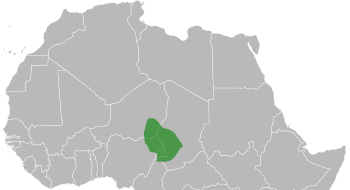 Bornu Empire extent c.1750 | |||||||||||
| العاصمة | Ngazargamu | ||||||||||
| اللغات المشتركة | Kanuri | ||||||||||
| الدين | Islam | ||||||||||
| الحكومة | Monarchy | ||||||||||
| King (Mai) | |||||||||||
• 1381–1382 | Said of Bornu | ||||||||||
| الحقبة التاريخية | Middle Ages | ||||||||||
• تأسست | 1380s | ||||||||||
• انحلت | 1893 | ||||||||||
| المساحة | |||||||||||
| 1800[9] | 50،000 km2 (19،000 sq mi) | ||||||||||
| 1892[10] | 129،499 km2 (50،000 sq mi) | ||||||||||
| التعداد | |||||||||||
• 1892[10] | 5000000 | ||||||||||
| |||||||||||
By the end of the 14th century, internal struggles and external attacks had torn Kanem apart. War with the So brought the death of four Mai: Selemma, Kure Gana, Kure Kura, and Muhammad, all sons of 'Abdullāh b. Kadai. Then, war with the Bulala resulted in the death of four Mai in succession between 1377 and 1387: Dawūd, Uthmān b. Dawūd, Uthmān b. Idris, and Bukar Liyāu. Finally, around 1387 the Bulala forced Mai Umar b. Idris to abandon Njimi and move the Kanembu people to Bornu on the western edge of Lake Chad.[7][8][11][4]
But even in Bornu, the Sayfawa Dynasty's troubles persisted. During the first three-quarters of the 15th century, for example, fifteen Mais occupied the throne. Then, around 1460 Ali Gazi (1473-1507) defeated his rivals and began the consolidation of Bornu. He built a fortified capital at Ngazargamu, to the west of Lake Chad (in present-day Nigeria), the first permanent home a Sayfawa mai had enjoyed in a century. So successful was the Sayfawa rejuvenation that by the early 16th century Mai Idris Katakarmabe (1507-1529) was able to defeat the Bulala and retake Njimi, the former capital. The empire's leaders, however, remained at Ngazargamu because its lands were more productive agriculturally and better suited to the raising of cattle. Ali Gaji was the first ruler of the empire to assume the title of Caliph.[12][3][2][7][8]
بسيطرتها على العاصمتين، أصبحت أسرة سايفاوة أكثر قوة من أي وقت مضى. اندمجت الدولتان، وإن استمر السلطة السياسية في أيدي البرنو. وقد وصلت البرنو كانم لسنام مجدها في عهد رجل الدولة العبقري ماي إدريس علومة (ح. 1571–1603).
وتمكن العاهل البرنوي ماي علي (في منتصف القرن السادس عشر الميلادي) من إخضاع قبائل البولالا واسترجاع العاصمة الأولى نجيمي.
إدريس ألوما
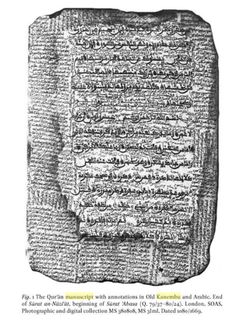
وصلت برنو قمة مجدها وتوسعها في عهد الماي إدريس علومة (ألوما). وسارت الدولة في عهد خلفائه (أبنائه الثلاثة)، بقوة الركائز التي وضعها والدهم. وجاء من بعدهم علي بن عمر (1055 – 1096هـ، 1645- 1685م)، وحافظ على ميراث جده إدريس، وظهر الضعف في خلفائه.
خلفاؤه
Most of the successors of Idris Alooma are only known from the meagre information provided by the Diwan. Some of them are noted for having undertaken the pilgrimage to Mecca others for their piety. In the eighteenth century Bornu was affected by several long-lasting famines.[13][7][8] Aïr was independently operating the Bilma salt mines by 1750, having been a tributary since 1532.[6][4]
The administrative reforms and military brilliance of Aluma sustained the empire until the mid-17th century when its power began to fade. By the late 18th century, Bornu rule extended only westward, into the land of the Hausa of modern Nigeria. The empire was still ruled by the Mai who was advised by his councilors (kokenawa) in the state council or "nokena".[14] The members of his Nokena council included his sons and daughters and other royalty (the Maina) and non-royalty (the Kokenawa, "new men"). The Kokenawa included free men and slave eunuchs known as kachela. The latter "had come to play a very important part in Bornu politics, as eunuchs did in many Muslim courts."[15]
During the 17th century and 18th century, Bornu became a centre for Islamic learning. Islam and the Kanuri language was widely adopted, while slave raiding propelled the economy.[4]
التدهور والسقوط
الجهاد الفولاني
استشرى الضعف في حكام البرنو إلى أن داهمهم الشيخ عثمان بن فودي نتيجة للموقف العدائي الذي وقفته منه برنو. وكادت الدولة تسقط في يد الشيخ عثمان دان فوديو لولا السياسة الجديدة التي انتهجها الشيخ محمد الأمين الكانمي الذي تولى السلطة عندما استعان به سلطانها.[8][16]
محمد الكانمي
محمد الأمين الكانمي contested the Fulani advance. Kanem was a Muslim scholar and non-Sayfawa warlord who had put together an alliance of Shuwa Arabs, Kanembu, and other seminomadic peoples. He eventually built in 1814 a capital at Kukawa (in present-day Nigeria). Sayfawa mais remained titular monarchs until 1846. In that year, the last mai, in league with the Ouaddai Empire, precipitated a civil war, resulting in the death of Mai Ibrahim, the last mai. It was at that point that Kanemi's son, Umar, became Shehu, thus ending one of the longest dynastic reigns in international history. By then, Hausaland in the west, was lost to the Sokoto Caliphate, while the east and north were lost to the Wadai Empire.[17][4][3][8]
عهد ما بعد سايفاوة
وظل حكم برنو في أسرة الكانمي إلى أن دخل رابح بن فضل الله الزبير البلاد سنة 1311هـ، 1893م، واستولى على السلطة إلى أن قتله المستعمرون الفرنسيون عام 1318هـ،1900م. وناضل من بعده ابنه فضل الله حتى غلبه الفرنسيون، وسقطت برنو في أيديهم سنة 1312هـ، 1901م.
انظر أيضاً
- أسرة سايفاوة
- تأريخ سايفاوة (كانم-برنو)
- الديوان (گيرگام)
- ابن فورتو (ابن فورتوا)
- مملكة باگرمي
- سلطنة وداي
- تاريخ نيجريا
- قائمة الأسرات المسلمة
المصادر
- ^ Shillington, page 733
- ^ أ ب ت خطأ استشهاد: وسم
<ref>غير صحيح؛ لا نص تم توفيره للمراجع المسماةUrvoy - ^ أ ب ت Meredith, Martin (2014). The Fortunes of Africa. New York: PublicAffairs. pp. 71, 78–79, 159–160. ISBN 9781610396356.
- ^ أ ب ت ث ج Shillington, Kevin (2012). History of Africa. Palgrave Macnikkan. pp. 94, 189. ISBN 9780230308473.
- ^ Koslow, Philip (1995). Kanem-Borno: 1,000 Years of Splendor. New York: Chelsea House Publishers. pp. 14, 20–21, 23. ISBN 0791031292.
- ^ أ ب خطأ استشهاد: وسم
<ref>غير صحيح؛ لا نص تم توفيره للمراجع المسماةNehemia - ^ أ ب ت ث ج خطأ استشهاد: وسم
<ref>غير صحيح؛ لا نص تم توفيره للمراجع المسماةSmith - ^ أ ب ت ث ج ح خ Palmer, Richmond (1936). The Bornu Sahara and Sudan. London: John Murray. pp. 166, 195, 223.
- ^ Oliver, page 12
- ^ Hughes, page 281
- ^ Smith, "Early states", 179; Lange, "Kingdoms and peoples", 238; Barkindo, "Early states", 245–6.
- ^ The History of Islam in Africa. Ohio University Press. p. 81.
{{cite book}}: Cite uses deprecated parameter|authors=(help) - ^ Lange, Diwan, 81-82.
- ^ Brenner, Shehus, 46, 104–7.
- ^ Ajayi, J. F. Ade.; Espie, Ian, eds. (1965). A Thousand Years of West African History: A Handbook for Teachers and Students. Ibadan, Nigeria: Ibadan University Press. p. 296.
- ^ Hiribarren, Vincent (2017). A History of Borno: Trans-Saharan African Empire to Failing Nigerian State. London: Hurst & Company. pp. 19–20. ISBN 9781849044745.
- ^ Brenner, Shehus, 64–66.
المراجع
- Alkali, Nur, and Bala Usman, eds., Studies in the History of Pre-Colonial Borno (Zaria: Northern Nigerian Publishing, 1983)
- Barkindo, Bawuro: "The early states of the Central Sudan: Kanem, Borno and some of their neighbours to c. 1500 AD.", in: J. Ajayi und M. Crowder (ed.), History of West Africa, Bd. I, 3rd ed. Harlow 1985, 225–254.
- Barth, Heinrich: Travel and Discoveries in North and Central Africa, vol. II, New York, 1858, 15–29, 581–602.
- Brenner, Louis, The Shehus of Kukawa, Oxford 1973.
- Kanem-Borno, in Thomas Collelo, ed. Chad: A Country Study. Washington: GPO for the Library of Congress, 1988.
- Dewière, Rémi, ‘Regards croisés entre deux ports de désert’, Hypothèses, 2013, 383–93
- Cohen, Ronald: The Kanuri of Bornu, New York 1967.
- Hallam, W.: The life and Times of Rabih Fadl Allah, Devon 1977.
- Hiribarren, Vincent, A History of Borno: Trans-Saharan African Empire to Failing Nigerian State (London: Hurst & Oxford University Press, 2017).
- Hughes, William (2007). A class-book of modern geography (Paperback). Whitefish, MT: Kessinger Publishing. p. 390 Pages. ISBN 1-4326-8180-X.
- Lange, Dierk: Le Dīwān des sultans du Kanem-Bornu, Wiesbaden 1977.
- -- A Sudanic Chronicle: The Borno Expeditions of Idris Alauma (1564–1576), Stuttgart 1987.
- -- "Ethnogenesis from within the Chadic state", Paideuma, 39 (1993), 261–277.
- -- "The Chad region as a crossroads", in: M. Elfasi (Hg.), General History of Africa, vol. III, UNESCO, London 1988, pp. 436–460.
- -- "The kingdoms and peoples of Chad", in: D. T. Niane (ed.), General History of Africa, vol. IV, UNESCO, London 1984, pp. 238–265.
- --: "An introduction to the history of Kanem-Borno: The prologue of the Dīwān", Borno Museum Society Newsletter 76–84 (2010), 79–103.
- --: The Founding of Kanem by Assyrian Refugees ca. 600 BCE: Documentary, Linguistic, and Archaeological Evidence, Boston 2011.
- Lavers, John, ‘Adventures in the chronology of the states of the Chad basin’, ed. by Daniel Barreteau and Charlotte de Graffenried (presented at the Datation et chronologie dans le bassin du lac Tchad. Dating and chronology in the lake Chad basin, Bondy: Orstom, 1993), pp. 255–67
- Levtzion, Nehemia, and John Hopkins: Corpus of Early Arabic Sources for West African History, Cambridge 1981.
- Nachtigal, Gustav: Sahara und Sudan, Berlin, 1879–1881, Leipzig 1989 (Nachdruck Graz 1967; engl. Übers. von Humphrey Fisher).
- Oliver, Roland & Anthony Atmore (2005). Africa Since 1800, Fifth Edition. Cambridge: Cambridge University Press. p. 405 Pages. ISBN 0-521-83615-8.
- Shillington, Kevin (2005). Encyclopedia of African History Volume 1 A–G. New York: Routledge. pp. 1912 pages. ISBN 1-57958-245-1.
- Smith, Abdullahi: The early states of the Central Sudan, in: J. Ajayi and M. Crowder (ed.), History of West Africa, vol. I, 1st ed., London, 1971, 158–183.
- Urvoy, Yves: L'empire du Bornou, Paris 1949.
- Trimingham, Spencer: A History of Islam in West Africa, Oxford 1962.
- Urvoy, Yves: L'empire du Bornou, Paris 1949.
- Van de Mieroop, Marc: A History of the Ancient Near East, 2nd ed., Oxford 2007.
- Zakari, Maikorema: Contribution à l'histoire des populations du sud-est nigérien, Niamey 1985.
- Zeltner, Jean-Claude : Pages d'histoire du Kanem, pays tchadien, Paris 1980.
قراءات إضافية
- Barkindo, Bawuro, "The early states of the Central Sudan: Kanem, Borno and some of their neighbours to c. 1500 A.D.", in: J. Ajayi und M. Crowder (Hg.), History of West Africa, Bd. I, 3. Ausg. Harlow 1985, 225–254.
- Lange, Dierk, Ancient Kingdoms of West Africa: Africa-Centred and Canaanite-Israelite Perspectives, Dettelbach 2004. (the book suggests a pre-Christian origin of Kanem in connection with the Phoenician expansion)
- Urvoy, Yves, L'empire du Bornou, Paris 1949.
- Lange, Dierk, "Immigration of the Chadic-speaking Sao towards 600 BCE" Borno Museum Society Newsletter, 72–75 (2008), 84–106.
وصلات خارجية
- CS1 errors: deprecated parameters
- Pages using infobox country with unknown parameters
- Pages using infobox country or infobox former country with the flag caption or type parameters
- Former country articles categorised by government type
- بلدان سابقة في أفريقيا
- تاريخ الكامرون
- تاريخ تشاد
- تاريخ شمال نيجريا
- امبراطوريات مسلمة
